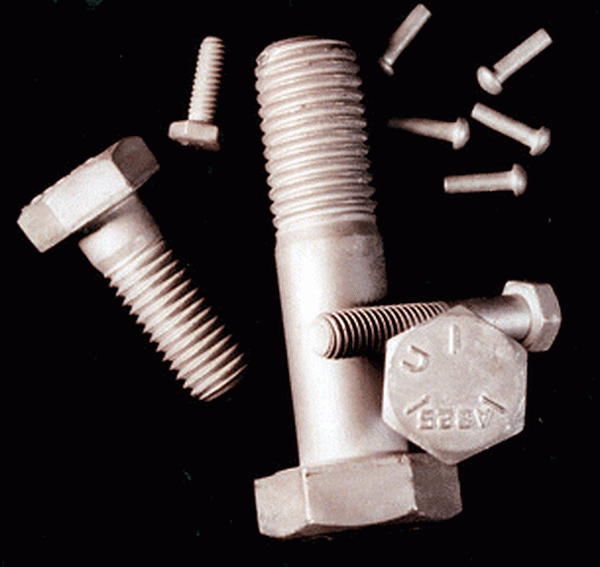ASTM A153 for Hardware

The specification ASTM A153/A153M applies to hardware products such as castings, fasteners, rolled, pressed, and forged products, and miscellaneous threaded objects that will be centrifuged, spun, or otherwise handled to remove excess zinc (Figure 12).
The requirements for ASTM A153/A153M are very similar to those stated earlier for ASTM A123/A123M, except for the addition of threaded products and embrittlement requirements.
ASTM A153/A153M Requirements
- Coating Thickness/Weight depends on the material category and steel thickness, values are listed in Table 3
- Threaded Products areas with threads are not subject to the coating thickness requirement
- Finish continuous, smooth, uniform
- Embrittlement high tensile strength fasteners (>150ksi) and castings can be subject to embrittlement
- Appearance free from uncoated areas, blisters, flux deposits and gross dross inclusions as well as having no heavy zinc deposits that interfere with intended use
- Adherence the entire coating should have a strong adherence throughout the service life of hot-dip galvanized steel
There are fabrication steps that may impair the corrosion protection of the hot-dip galvanized coating; however, flaking or damage to the coating because of this is not case for rejection. In all cases, good steel selection results in the formation of a higher quality coating and finish on the product. The corrosion protection coating for threaded products is applied after the product has been fabricated and further fabrication may compromise the corrosion protection system. The one exception to this rule is the internal threads of a nut that should be over-tapped after the coating is applied in order to accommodate the coating thickness change on the thread of the bolts. In this case, the zinc on the bolt threads provides the corrosion protection to the uncoated threads in the nut.
There are certain fabrication techniques that can induce stresses into the steel and lead to brittle failure. There are precautions given in ASTM A143/A143M that should be taken in order to prevent embrittlement. In addition, selecting steels with appropriate chemistries can help prevent embrittlement of malleable castings. A reproduction and summary of the table given in ASTM A153/A153M, (Table 3), gives the different classes of products and the minimum coating thickness required by the specification.
Table 3
| Thickness or Weight (Mass) of Zinc Coating for Various Classes of Material | ||||
|---|---|---|---|---|
| Weight (Mass) of Zinc Coating, oz/ft2 (g/m2) of Surface, minimum | Coating Thickness, mils (microns), Minimum | |||
| Class of Material | Average of Specimens Tested | Any Individual Specimen | Average of Specimens Tested | Any Individual Specimen |
| Class A - Castings - Malleable Iron, Steel | 2.00 (610) | 1.80 (550) | 3.4 (86) | 3.1 (79) |
| Class B - Rolled, Pressed, and Forged articles (except those which would be included under Classes C and D)
B-1: > 5/8” (15.88 mm) and > 15” (381 mm) in length | 2.00 (610) | 1.80 (550) | 3.5 (85) | 3.1 (79) |
B-2: < 5/8” (15.88 mm) and > 15” (381 mm) in length | 1.5 (458) | 1.25 (381) | 2.6 (66) | 2.1 (53) |
| B-3: any thickness and < 15” (381 mm) in length | 1.30 (397) | 1.10 (336) | 2.2 (56) | 1.9 (48) |
| Class C - Fasteners over 3/8” (9.52 mm) in diameter. Washers > 3/16” (4.76 mm) in thickness | 1.25 (381) | 1.00 (305) | 2.1 (53) | 1.7 (43) |
| Class D - Fasteners < 3/8” (9.52 mm) in diameter. Rivets, nails and similar articles. Washers < 3/16” (4.76 mm) in thickness. | 1.00 (305) | 0.85 (259) | 1.7 (43) | 1.4 (36) |
| Note 1: Length of the piece, stated in Classes B-1, B-2, B-3, refers to the finished dimensiosn of the piece after fabrication | ||||